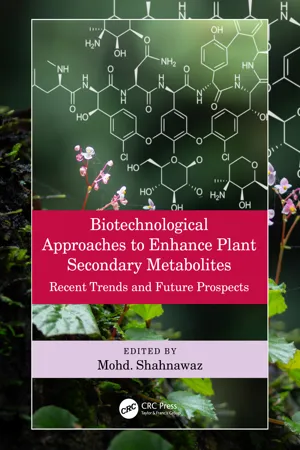
Biotechnological Approaches to Enhance Plant Secondary Metabolites
Recent Trends and Future Prospects
Mohd. Shahnawaz, Mohd. Shahnawaz
- 168 pages
- English
- ePUB (adapté aux mobiles)
- Disponible sur iOS et Android
Biotechnological Approaches to Enhance Plant Secondary Metabolites
Recent Trends and Future Prospects
Mohd. Shahnawaz, Mohd. Shahnawaz
À propos de ce livre
Thousands of secondary metabolites are produced by plants to withstand unfavourable environmental conditions and are important molecules for nutraceutical, agro, cosmetic and pharmaceutical industries, etc. Harvesting of plants for the extraction of these important metabolites can threaten the plant germplasm, and various medicinally important plants are at the verge of extinction. Based on need, various methods and strategies were developed and followed by researchers from time to time to save the plant germplasm and produce important secondary metabolites efficiently to meet their growing demands.
Biotechnological Approaches to Enhance Plant Secondary Metabolites: Recent Trends and Future Prospects provides a comprehensive introduction and review of state-of-the-art biotechnological tools in this field of research at global level. The methodologies are highlighted by real data examples in both in vitro and in vivo level studies.
The book:
• Highlights and provides overviews of the synthesis, classification, biological function and medicinal applications of the recent advancements for the enhanced production of novel secondary metabolites in plants
• Provides an overview of the role of induced mutation, salinity stress and brassinosteroids impact to increase the secondary metabolic contents in plants and suggests an increase in enzymatic activity in plants could be due to various point mutations, which in turn could play a role at transcriptome levels
• Discusses the significant role of endophytes to enhance the contents of plant secondary metabolites
• Alternatively, suggests the urgent need to set up the standard operating procedures using hydroponics system of cultivation for significant enhancement of secondary metabolite contents
• Enlists various in vitro techniques to enhance plant secondary metabolites contents using plant tissue culture approaches
• Provides a systematic overview of state-of-the-art biotechnological tools CRISPER Cas9 and RNAi to enhance the plant secondary metabolite contents
• Recommends CRISPER Cas9 technology over RNAi, ZFNs and TALENs because of its relatively simple and high precision method with an easily programmable tool
This serves as a reference book for the researchers working in the field of plant secondary metabolites and pharmaceutical industries at global level.
Foire aux questions
Informations
1Plant Secondary Metabolites—The Key Drivers of Plant's Defence MechanismsA General Introduction
CONTENTS
- 1.1Introduction
- 1.2Classification of Secondary Metabolites
- 1.2.1Terpenes (Terpenoids)
- 1.2.1.1Synthesis of Terpenes
- 1.2.1.2Classification of Terpenes
- 1.2.1.3Extraction and Identification of Terpenes
- 1.2.1.4Role and Application of Terpenes
- 1.2.1.5Essential Oil
- 1.2.2Alkaloids
- 1.2.2.1Synthesis of Alkaloids
- 1.2.2.2Classification of Alkaloids
- 1.2.2.3Extraction and Identification of Alkaloids
- 1.2.2.4Role and Application of Alkaloids
- 1.2.3Phenolics
- 1.2.3.1Synthesis of Phenolics
- 1.2.3.2Classification of Phenolics
- 1.2.3.3Extraction and Identification of Phenolics
- 1.2.3.4Role and Application of Phenolics
- 1.3Current Biotechnological Approaches for the Enhancement of Secondary Metabolite Contents in Plants
- 1.4Conclusion
- Acknowledgements
- References
1.1INTRODUCTION
1.2CLASSIFICATION OF SECONDARY METABOLITES
1.2.1TERPENES (TERPENOIDS)
Table des matières
- Cover
- Half Title
- Title Page
- Copyright Page
- Dedication
- Contents
- Preface
- Acknowledgements
- Editor
- Contributors
- Chapter 1 Plant Secondary Metabolites—The Key Drivers of Plant's Defence Mechanisms: A General Introduction
- Chapter 2 Generation of Plant Mutant Lines Using Gamma Radiation with Enhanced Secondary Metabolite Contents
- Chapter 3 Salinity Stress and Plant Secondary Metabolite Enhancement: An Overview
- Chapter 4 Enhancement of Plant Secondary Metabolites Using Fungal Endophytes
- Chapter 5 Hydroponic Cultivation Approaches to Enhance the Contents of the Secondary Metabolites in Plants
- Chapter 6 Tissue Culture Approaches to Enhance Plant Secondary Metabolites Production
- Chapter 7 Hairy Roots and Plant Secondary Metabolites Production: An Update
- Chapter 8 Brassinosteroids: The Phytohormones with Potential to Enhance the Secondary Metabolite Production in Plants
- Chapter 9 CRISPR-Cas9 Approaches to Enhance Contents of Plant Secondary Metabolites
- Chapter 10 RNA Interference for Improvement of Secondary Metabolite Production in Plants
- Index